if you're singing by yourself
music by uma floresta
ghosting small studio
deedee popper, caity gwin, patrick gallager, jeremy pheiffer, layla guest, peggy gould and tony schultz

 Otis' still acts retain a high kinetic energy in the frame of the passing viewer due to their great velocity and his close proximity to the road. As his text indicates, the scattering interactions are complex and worth serious study.
Otis' still acts retain a high kinetic energy in the frame of the passing viewer due to their great velocity and his close proximity to the road. As his text indicates, the scattering interactions are complex and worth serious study.  Capital also works as a time machine in multiple ways. First is through propagating past debts into the future through interest and the setting of present prices through speculation and secret knowledge. True believers say the market is the most intelligent predictor of the future. Some think otherwise.
Capital also works as a time machine in multiple ways. First is through propagating past debts into the future through interest and the setting of present prices through speculation and secret knowledge. True believers say the market is the most intelligent predictor of the future. Some think otherwise. Downtown, on Wall St. Otis trys to communicate to foot traffickers. Here the time scale and landscape require different tactics: the voice and higher frequency gestures are used since duration is blocked by the state. Otis has a good understanding of capital since he spends time with bankers moving weight in the financial district. They are big and sloppy he tells me. Though they push a lot around they inevitably leave a mess for others to clean up. Perhaps naïve art is not so naïve.
Downtown, on Wall St. Otis trys to communicate to foot traffickers. Here the time scale and landscape require different tactics: the voice and higher frequency gestures are used since duration is blocked by the state. Otis has a good understanding of capital since he spends time with bankers moving weight in the financial district. They are big and sloppy he tells me. Though they push a lot around they inevitably leave a mess for others to clean up. Perhaps naïve art is not so naïve. 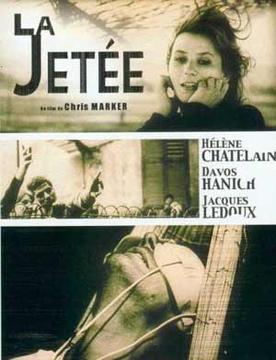 Schizophrenic time travel uses image as a tool. Chris Marker's 1962 French sci-fi classic La jetée elaborates this. The film, consisting almost entirely of still photos, depicts a post-nuclear future in which the protagonist is subject to experiments to displace him in time. Whether the travel is real or imagined remains ambiguous. The goal of his trip is to avert nuclear war and recapture lost love. This is the inspiration of Terry Gilliam's 12 Monkeys.
Schizophrenic time travel uses image as a tool. Chris Marker's 1962 French sci-fi classic La jetée elaborates this. The film, consisting almost entirely of still photos, depicts a post-nuclear future in which the protagonist is subject to experiments to displace him in time. Whether the travel is real or imagined remains ambiguous. The goal of his trip is to avert nuclear war and recapture lost love. This is the inspiration of Terry Gilliam's 12 Monkeys.@Book{Rodowick1997,
author = {Rodowick, David Norman},
title = {Gilles Deleuze's Time Machine},
publisher = {MIT},
year = {2004},
address = {Cambridge},
isbn = {0822319705}
}
 "Mrs Miltch is utilizing music as a method of reaching the autustic children at B-G...the dance,in particular."
"Mrs Miltch is utilizing music as a method of reaching the autustic children at B-G...the dance,in particular."@Book{Slip,
author = {Dick, Philip K.},
title = {Martian Time-Slip},
publisher = {Ballatine},
year = {1964},
isbn = {0679761675}
}


 Their site describes DNCHRD IV as "a dance competition in 6 colors. Six color-coordinated dance crews led by 6 Dance Captains show off their choreography during an interactive rock show."
Their site describes DNCHRD IV as "a dance competition in 6 colors. Six color-coordinated dance crews led by 6 Dance Captains show off their choreography during an interactive rock show."  LVHRD is something of a chimera, part art circle, part drinking club, part secret society and part branding machine. Dewar's is their most visible advertising partner. It supplies alcohol for all of their events and its branding can be seen throughout the LVHRD website, photography and video content.
LVHRD is something of a chimera, part art circle, part drinking club, part secret society and part branding machine. Dewar's is their most visible advertising partner. It supplies alcohol for all of their events and its branding can be seen throughout the LVHRD website, photography and video content. I am not sure I know what I am getting into or how I feel about a the confluence of commerce and culture wars. To me red stands for radicalism and an anti-corporate ideology. Red stands for passion and sanguinity. When it comes to spirited beverages red stands for apple cider.
I am not sure I know what I am getting into or how I feel about a the confluence of commerce and culture wars. To me red stands for radicalism and an anti-corporate ideology. Red stands for passion and sanguinity. When it comes to spirited beverages red stands for apple cider.
 Happy interpolating! Code in the comments section.
Happy interpolating! Code in the comments section.
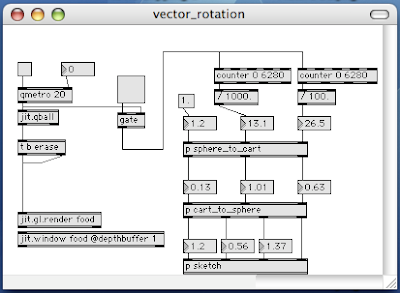
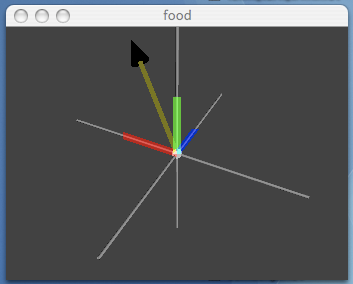 The patch has rotations going all over the place. Using a spherical coordinate system makes it possible to generate these rotations in q (theta) and f (phi). In the guts of the patch the orientation of the graphic arrow model is determined by using theta and phi as euler angles.
The patch has rotations going all over the place. Using a spherical coordinate system makes it possible to generate these rotations in q (theta) and f (phi). In the guts of the patch the orientation of the graphic arrow model is determined by using theta and phi as euler angles.
 Cartesian coordinates present the most straightforward means of representing a vector. In cartesian coordinates vectors can be added and subtracted by adding and subtracting their respective x, y and z coordinates.
Cartesian coordinates present the most straightforward means of representing a vector. In cartesian coordinates vectors can be added and subtracted by adding and subtracting their respective x, y and z coordinates. Physical quantities such as force, acceleration, velocity and displacement are all vector quantities. In the gravity simulator we dealt with all 4 of these in their 2-D vector form. We also are dealing with vectors when extraction accelerometer data from the Wii remote.
Physical quantities such as force, acceleration, velocity and displacement are all vector quantities. In the gravity simulator we dealt with all 4 of these in their 2-D vector form. We also are dealing with vectors when extraction accelerometer data from the Wii remote.

 Here is a patch that lets you play with 3-D spherical coordinates. The code is in the comments section. Since it uses cartesian coordinates we translate from spherical to cartesian as we send messages to OpenGL.
Here is a patch that lets you play with 3-D spherical coordinates. The code is in the comments section. Since it uses cartesian coordinates we translate from spherical to cartesian as we send messages to OpenGL. 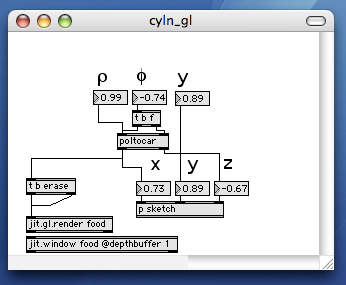
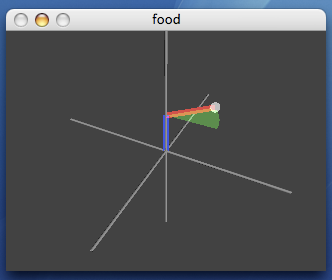 Here is a patch that lets you play with 3-D cylindrical coordinates. The code is in the comments section. Since it uses cartesian coordinates we translate from cylindrical to cartesian as we send messages to OpenGL.
Here is a patch that lets you play with 3-D cylindrical coordinates. The code is in the comments section. Since it uses cartesian coordinates we translate from cylindrical to cartesian as we send messages to OpenGL.
 Lots of very exciting mathematics surrounds this relationship between polar and cartesian coordiantes by way of exponentials and complex numbers. One such jewel is Euler's formula.
Lots of very exciting mathematics surrounds this relationship between polar and cartesian coordiantes by way of exponentials and complex numbers. One such jewel is Euler's formula.

 OpenGL uses Cartesian coordinates x, y, z for placement of objects, light source, viewpoint and focus point. The code is in the comments section.
OpenGL uses Cartesian coordinates x, y, z for placement of objects, light source, viewpoint and focus point. The code is in the comments section.
 In this coordinate system two numbers, x and y, specify a point in a plane. The name Cartesian comes from Descartes who is said to have "invented" the system while laying in bed sick and watching a fly crawl across the tiled ceiling.
In this coordinate system two numbers, x and y, specify a point in a plane. The name Cartesian comes from Descartes who is said to have "invented" the system while laying in bed sick and watching a fly crawl across the tiled ceiling.
 It is the Fourier transform of the multiplication operator and useful in physics and signal processing.The integral equation for using the quantum mechanical propagator K reduces to a convolution if it depends only on relative differences in space and time. K=K(x-x',t-t')
It is the Fourier transform of the multiplication operator and useful in physics and signal processing.The integral equation for using the quantum mechanical propagator K reduces to a convolution if it depends only on relative differences in space and time. K=K(x-x',t-t') Here is a patch using convolution with a drifting time series and a set of different kernel functions. The output time series is the convolution of the input time series and the kernel function. Click on all of the different kernel functions to see how they change the output signal.
Here is a patch using convolution with a drifting time series and a set of different kernel functions. The output time series is the convolution of the input time series and the kernel function. Click on all of the different kernel functions to see how they change the output signal.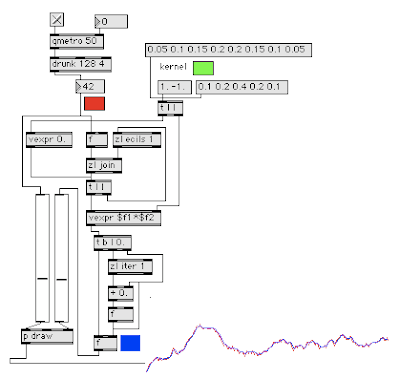 We are colonizing a field. Source code in comments section.
We are colonizing a field. Source code in comments section.
 Simulation is a great way to learn about gravity. So is dancing.
Simulation is a great way to learn about gravity. So is dancing. This is a simple physics engine for simulating a particle in a central force field. The code is in the comments section. Here is an example of what you can do with it.
This is a simple physics engine for simulating a particle in a central force field. The code is in the comments section. Here is an example of what you can do with it.